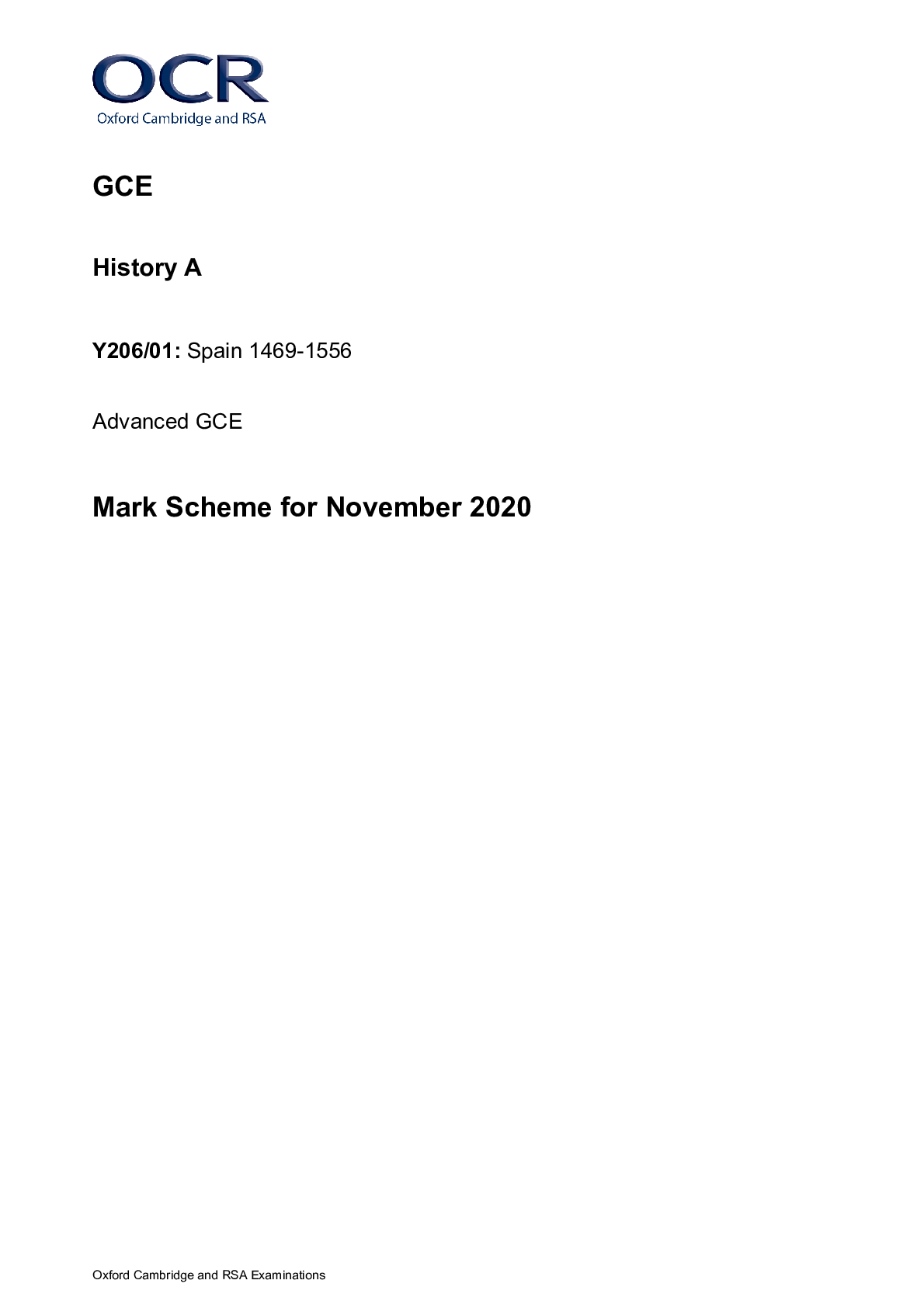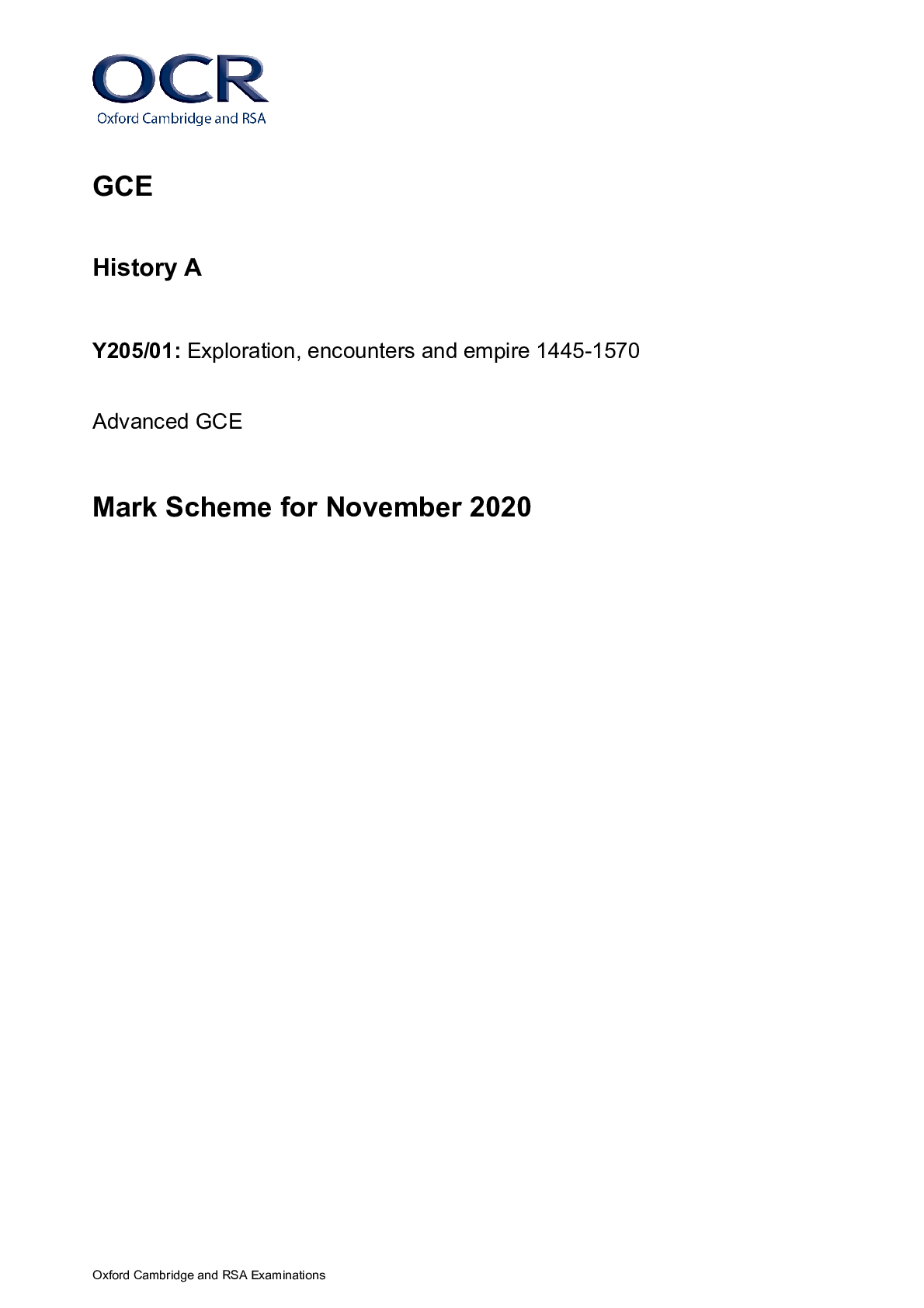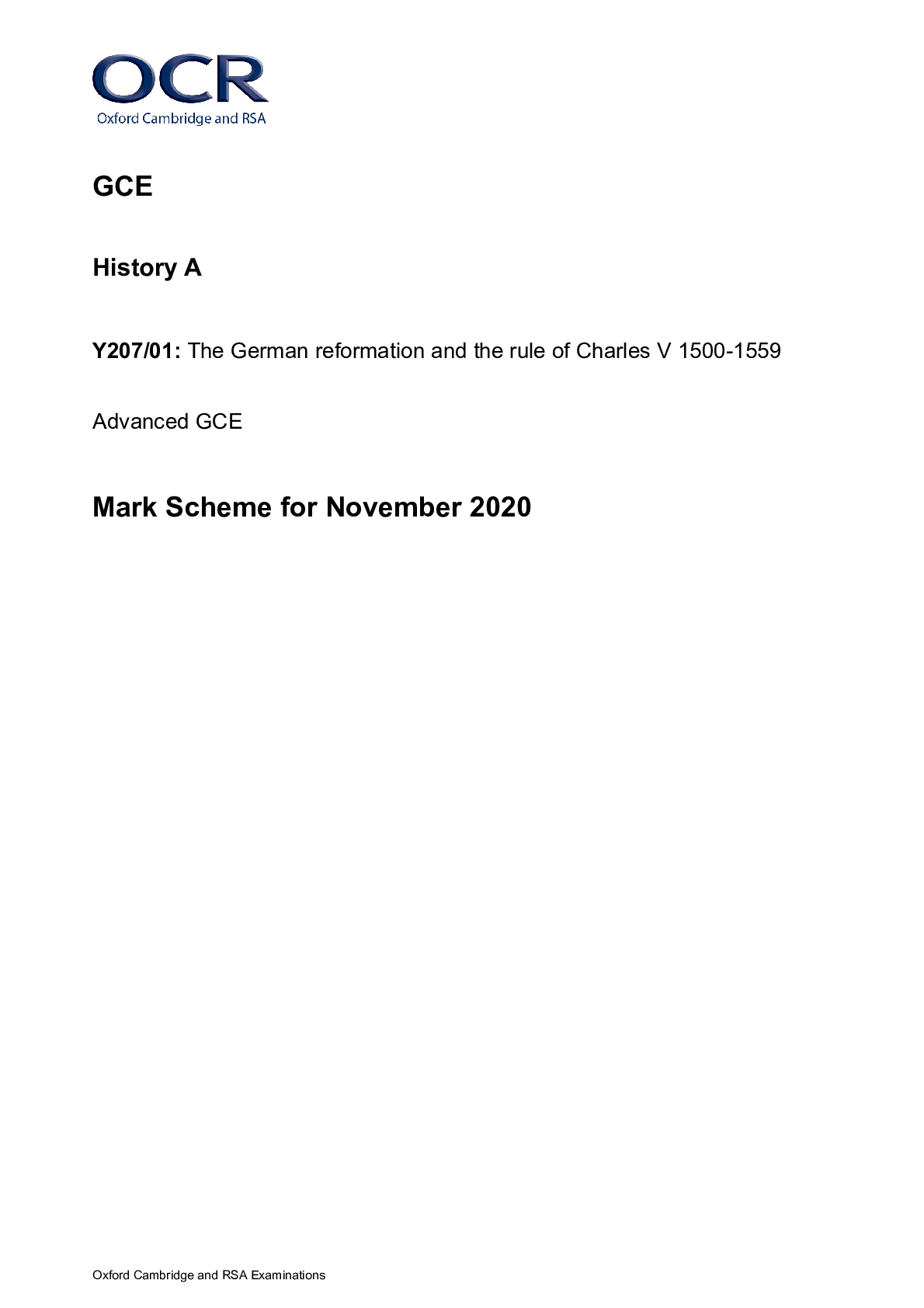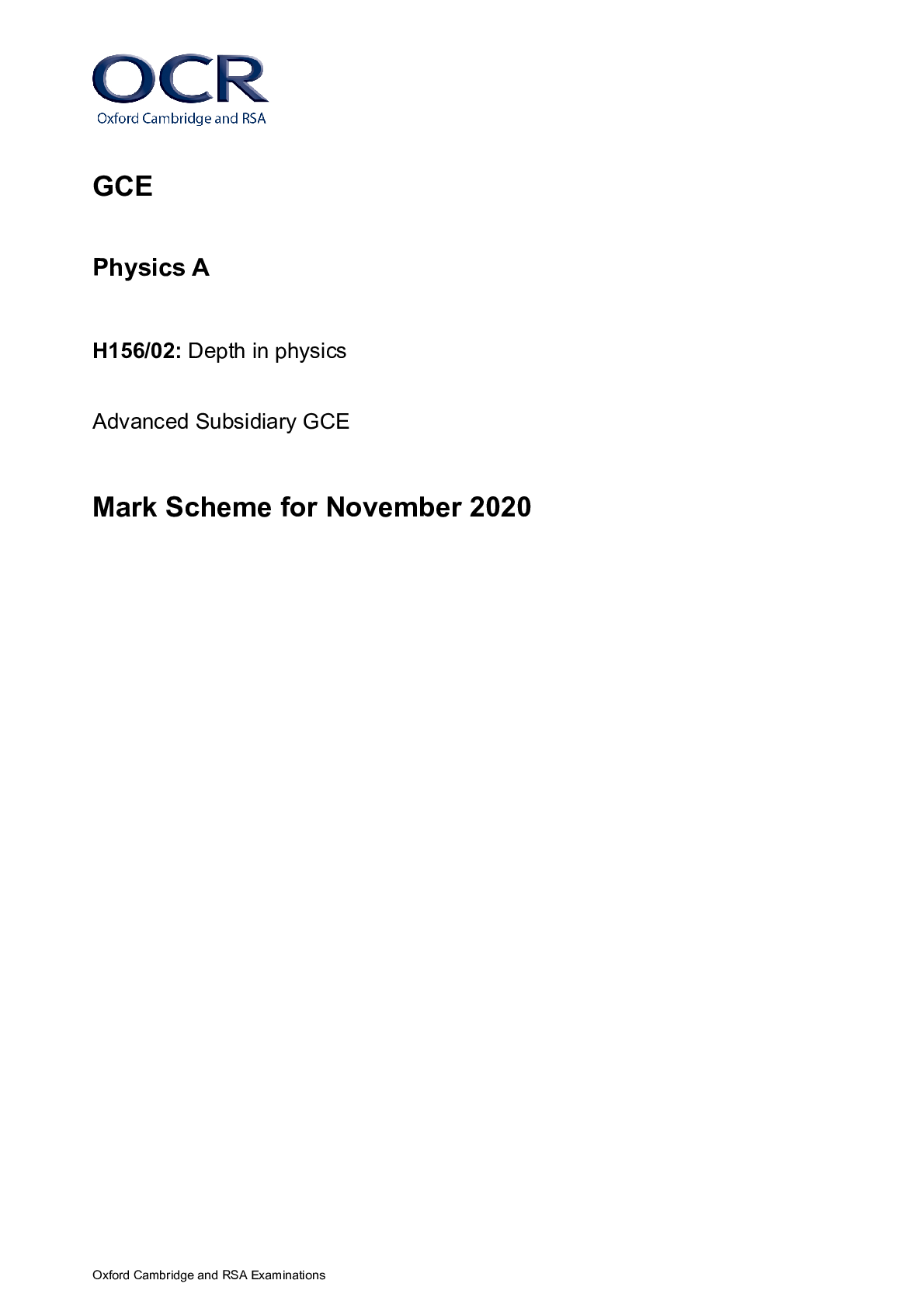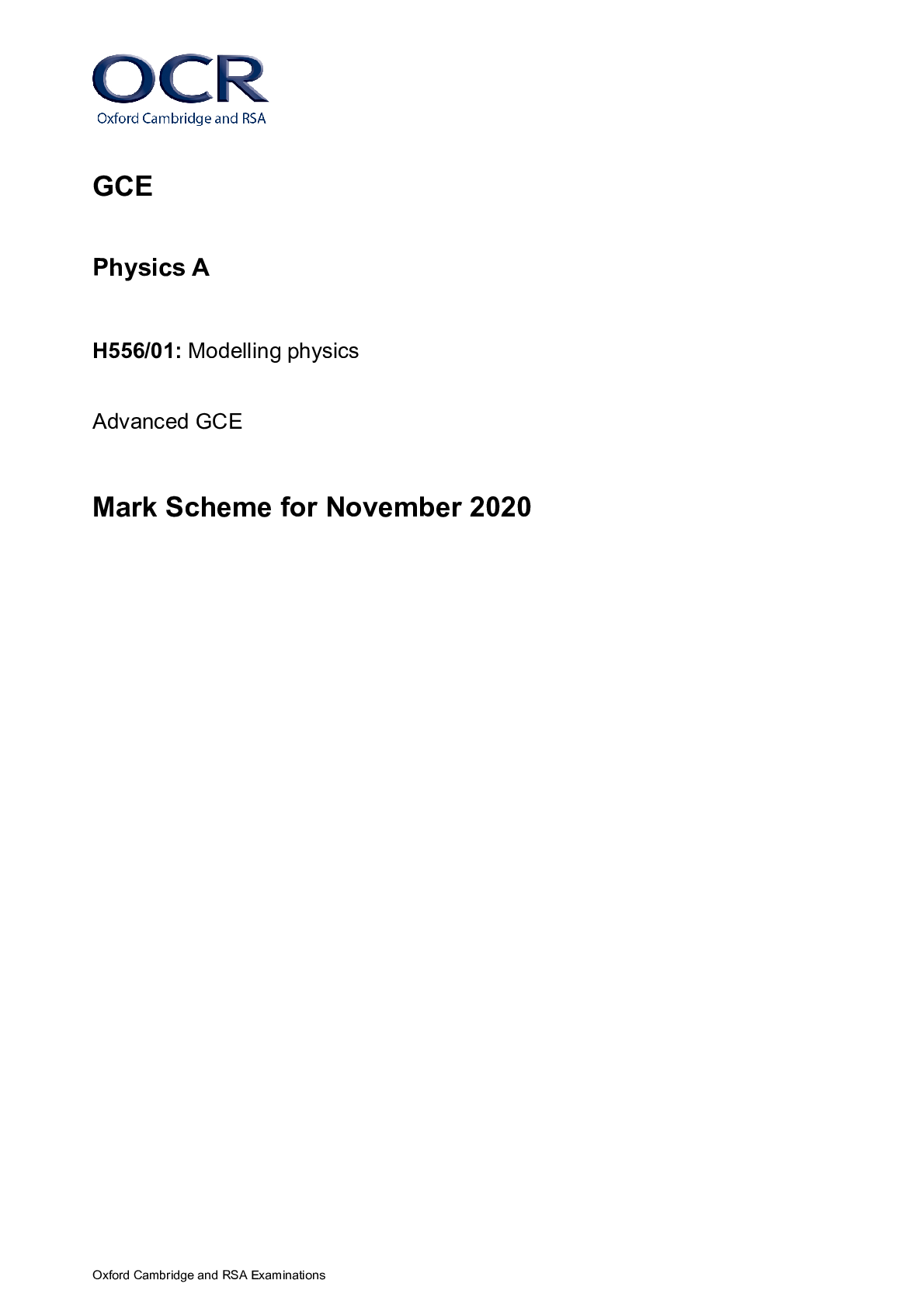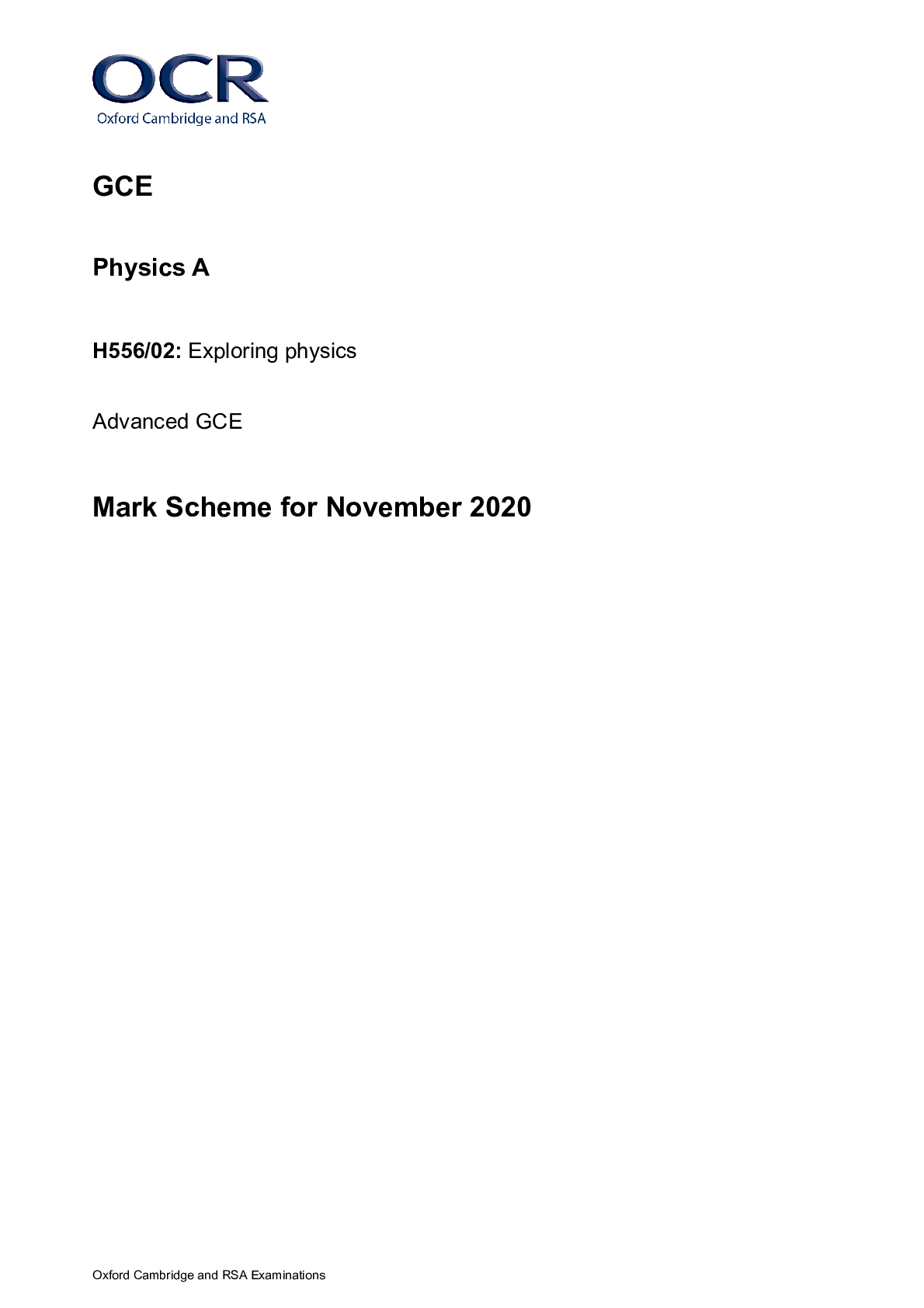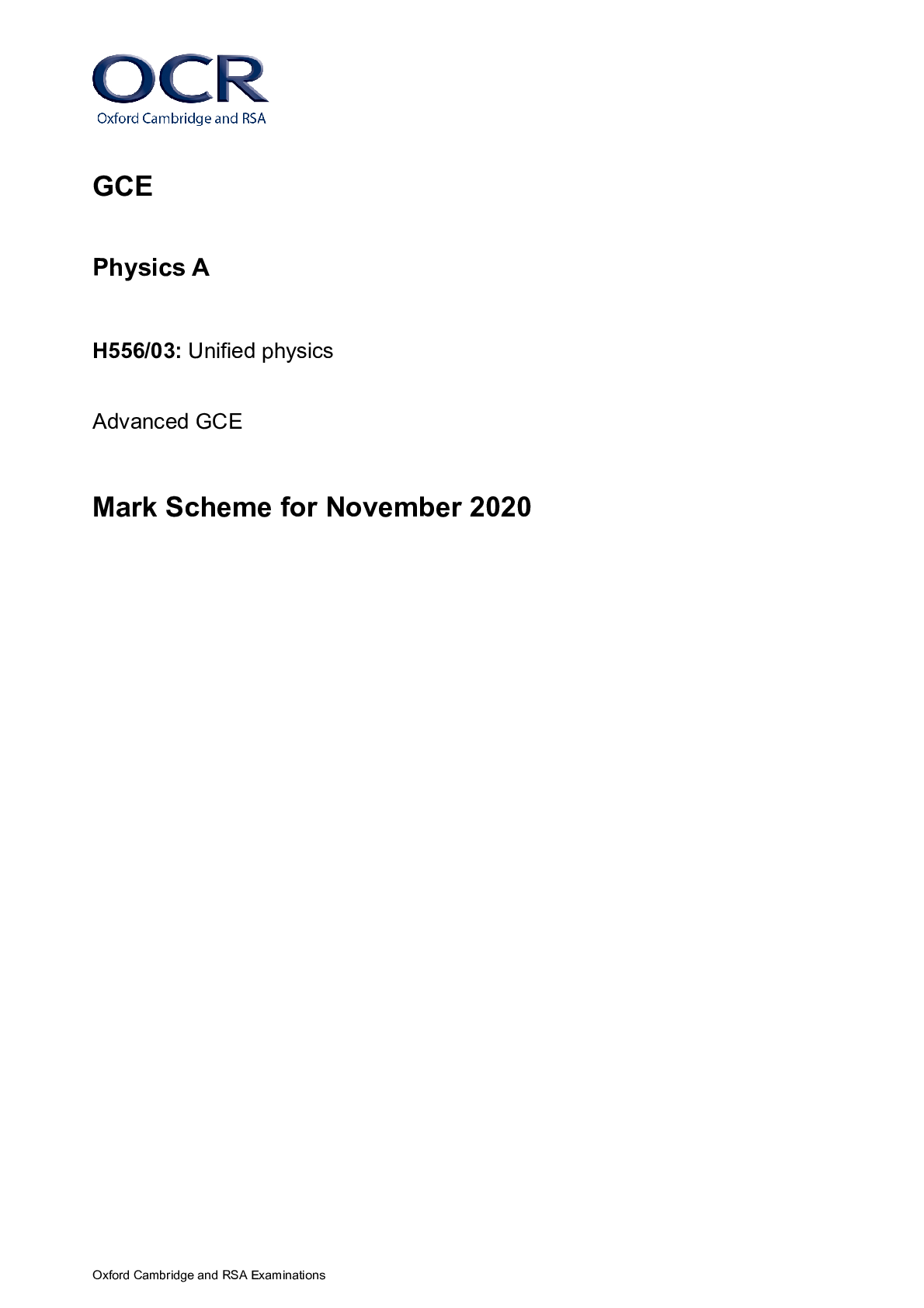Mathematics > AS Mark Scheme > GCE Further Mathematics A Y531/01: Pure Core Advanced Subsidiary GCE Mark Scheme for November 2020 (All)
GCE Further Mathematics A Y531/01: Pure Core Advanced Subsidiary GCE Mark Scheme for November 2020
Document Content and Description Below
Oxford Cambridge and RSA Examinations GCE Further Mathematics A Y531/01: Pure Core Advanced Subsidiary GCE Mark Scheme for November 2020Oxford Cambridge and RSA Examinations OCR (Oxford Cambridg... e and RSA) is a leading UK awarding body, providing a wide range of qualifications to meet the needs of candidates of all ages and abilities. OCR qualifications include AS/A Levels, Diplomas, GCSEs, Cambridge Nationals, Cambridge Technicals, Functional Skills, Key Skills, Entry Level qualifications, NVQs and vocational qualifications in areas such as IT, business, languages, teaching/training, administration and secretarial skills. It is also responsible for developing new specifications to meet national requirements and the needs of students and teachers. OCR is a not-for-profit organisation; any surplus made is invested back into the establishment to help towards the development of qualifications and support, which keep pace with the changing needs of today’s society. This mark scheme is published as an aid to teachers and students, to indicate the requirements of the examination. It shows the basis on which marks were awarded by examiners. It does not indicate the details of the discussions which took place at an examiners’ meeting before marking commenced. All examiners are instructed that alternative correct answers and unexpected approaches in candidates’ scripts must be given marks that fairly reflect the relevant knowledge and skills demonstrated. Mark schemes should be read in conjunction with the published question papers and the report on the examination. © OCR 2020Y531/01 Mark Scheme November 2020 2 Text Instructions 1. Annotations and abbreviations Annotation in RM assessor Meaning and BOD Benefit of doubt FT Follow through ISW Ignore subsequent working M0, M1 Method mark awarded 0, 1 A0, A1 Accuracy mark awarded 0, 1 B0, B1 Independent mark awarded 0, 1 SC Special case ^ Omission sign MR Misread BP Blank Page Seen Highlighting Other abbreviations in mark scheme Meaning dep* Mark dependent on a previous mark, indicated by *. The * may be omitted if only one previous M mark cao Correct answer only oe Or equivalent rot Rounded or truncated soi Seen or implied www Without wrong working AG Answer given awrt Anything which rounds to BC By Calculator DR This question included the instruction: In this question you must show detailed reasoning.Y531/01 Mark Scheme November 2020 3 2. Subject-specific Marking Instructions for A Level Mathematics A a Annotations must be used during your marking. For a response awarded zero (or full) marks a single appropriate annotation (cross, tick, M0 or ^) is sufficient, but not required. For responses that are not awarded either 0 or full marks, you must make it clear how you have arrived at the mark you have awarded and all responses must have enough annotation for a reviewer to decide if the mark awarded is correct without having to mark it independently. It is vital that you annotate standardisation scripts fully to show how the marks have been awarded. Award NR (No Response) - if there is nothing written at all in the answer space and no attempt elsewhere in the script - OR if there is a comment which does not in any way relate to the question (e.g. ‘can’t do’, ‘don’t know’) - OR if there is a mark (e.g. a dash, a question mark, a picture) which isn’t an attempt at the question. Note: Award 0 marks only for an attempt that earns no credit (including copying out the question). If a candidate uses the answer space for one question to answer another, for example using the space for 8(b) to answer 8(a), then give benefit of doubt unless it is ambiguous for which part it is intended. b An element of professional judgement is required in the marking of any written paper. Remember that the mark scheme is designed to assist in marking incorrect solutions. Correct solutions leading to correct answers are awarded full marks but work must not always be judged on the answer alone, and answers that are given in the question, especially, must be validly obtained; key steps in the working must always be looked at and anything unfamiliar must be investigated thoroughly. Correct but unfamiliar or unexpected methods are often signalled by a correct result following an apparently incorrect method. Such work must be carefully assessed. When a candidate adopts a method which does not correspond to the mark scheme, escalate the question to your Team Leader who will decide on a course of action with the Principal Examiner. If you are in any doubt whatsoever you should contact your Team Leader.Y531/01 Mark Scheme November 2020 4 c The following types of marks are available. M A suitable method has been selected and applied in a manner which shows that the method is essentially understood. Method marks are not usually lost for numerical errors, algebraic slips or errors in units. However, it is not usually sufficient for a candidate just to indicate an intention of using some method or just to quote a formula; the formula or idea must be applied to the specific problem in hand, e.g. by substituting the relevant quantities into the formula. In some cases the nature of the errors allowed for the award of an M mark may be specified. A method mark may usually be implied by a correct answer unless the question includes the DR statement, the command words “Determine” or “Show that”, or some other indication that the method must be given explicitly. A Accuracy mark, awarded for a correct answer or intermediate step correctly obtained. Accuracy marks cannot be given unless the associated Method mark is earned (or implied). Therefore M0 A1 cannot ever be awarded. B Mark for a correct result or statement independent of Method marks. Unless otherwise indicated, marks once gained cannot subsequently be lost, e.g. wrong working following a correct form of answer is ignored. Sometimes this is reinforced in the mark scheme by the abbreviation isw. However, this would not apply to a case where a candidate passes through the correct answer as part of a wrong argument. d When a part of a question has two or more ‘method’ steps, the M marks are in principle independent unless the scheme specifically says otherwise; and similarly where there are several B marks allocated. (The notation ‘dep*’ is used to indicate that a particular mark is dependent on an earlier, asterisked, mark in the scheme.) Of course, in practice it may happen that when a candidate has once gone wrong in a part of a question, the work from there on is worthless so that no more marks can sensibly be given. On the other hand, when two or more steps are successfully run together by the candidate, the earlier marks are implied and full credit must be given. e The abbreviation FT implies that the A or B mark indicated is allowed for work correctly following on from previously incorrect results. Otherwise, A and B marks are given for correct work only – differences in notation are of course permitted. A (accuracy) marks are not given for answers obtained from incorrect working. When A or B marks are awarded for work at an intermediate stage of a solution, there may be various alternatives that are equally acceptable. In such cases, what is acceptable will be detailed in the mark scheme. If this is not the case please, escalate the question to your Team Leader who will decide on a course of action with the Principal Examiner. Sometimes the answer to one part of a question is used in a later part of the same question. In this case, A marks will often be ‘follow through’. In such cases you must ensure that you refer back to the answer of the previous part question even if this is not shown within the image zone. You may find it easier to mark follow through questions candidate-by-candidate rather than question-by-question. f We are usually quite flexible about the accuracy to which the final answer is expressed; over-specification is usually only penalised where the scheme explicitly says so. • When a value is given in the paper only accept an answer correct to at least as many significant figures as the given value.Y531/01 Mark Scheme November 2020 5 • When a value is not given in the paper accept any answer that agrees with the correct value to 3 s.f. unless a different level of accuracy has been asked for in the question, or the mark scheme specifies an acceptable range. NB for Specification B (MEI) the rubric is not specific about the level of accuracy required, so this statement reads “2 s.f”. Follow through should be used so that only one mark in any question is lost for each distinct accuracy error. Candidates using a value of 9.80, 9.81 or 10 for g should usually be penalised for any final accuracy marks which do not agree to the value found with 9.8 which is given in the rubric. g Rules for replaced work and multiple attempts: • If one attempt is clearly indicated as the one to mark, or only one is left uncrossed out, then mark that attempt and ignore the others. • If more than one attempt is left not crossed out, then mark the last attempt unless it only repeats part of the first attempt or is substantially less complete. • if a candidate crosses out all of their attempts, the assessor should attempt to mark the crossed out answer(s) as above and award marks appropriately. h For a genuine misreading (of numbers or symbols) which is such that the object and the difficulty of the question remain unaltered, mark according to the scheme but following through from the candidate’s data. A penalty is then applied; 1 mark is generally appropriate, though this may differ for some units. This is achieved by withholding one A or B mark in the question. Marks designated as cao may be awarded as long as there are no other errors. If a candidate corrects the misread in a later part, do not continue to follow through. Note that a miscopy of the candidate’s own working is not a misread but an accuracy error. i If a calculator is used, some answers may be obtained with little or no working visible. Allow full marks for correct answers, provided that there is nothing in the wording of the question specifying that analytical methods are required such as the bold “In this question you must show detailed reasoning”, or the command words “Show” or “Determine”. Where an answer is wrong but there is some evidence of method, allow appropriate method marks. Wrong answers with no supporting method score zero. If in doubt, consult your Team Leader. j If in any case the scheme operates with considerable unfairness consult your Team Leader.Y531/01 Mark Scheme November 2020 6 Question Answer Marks AO Guidance 1 DR (a + bi)2 = a2 – b2 + 2abi B1 1.1 Seen or implied in solution a2 – b2 = –77 and 2ab = –36 (where a and b are real) M1 1.1 Comparing real and imaginary parts (no i unless later recovered) from a 3 term expansion Allow equating real and imaginary considering (a+ib)(c+id) 2 2 4 2 18 18 77 77 324 0 b a a a a a = − ⇒ − − = − ⇒ + − = M1 1.1 Eliminating b or a to obtain 3 term quadratic in a2 or b2. Unknowns must not be in denominator and non-zero terms on same side. = 0 seen or implied by solution. (b4 – 77b2 – 324 = 0) Factorised forms: (b2 – 81)(b2 + 4) (a2 – 4)(a2 + 81) = 0 B1 2.1 DR requires evidence of solving quadratic in a2 (or b2). Can be implied by sight of all 4 solutions. a2 = 4 or b2 = 81 only A1ft 2.3 Rogue solutions; a2 = –81, b2 = – 4 . Any rogue solutions must be discarded before A1 awarded. For follow through need to discard rogue solutions 2 – 9i and –2 + 9i A1 1.1 Both roots. Can use ± but not ±2 ± 9i and not ± 2 – 9i. ±(2 – 9i), ±(–2 + 9i) or ±2 m 9i are all acceptable. 2 – 9i and – 2 + 9i without working from quartic could score B1M1M1B0A0A1 [6]Y531/01 Mark Scheme November 2020 7 Question Answer Marks AO Guidance 2 (a) 1 0 0 1 = − A B1 1.2 [1] (b) . 0 . 1 B1 1.1 0 0 1 1 → ie y-axis invariant 1 0 . . or . . 2 1 insufficient for B1 1 . 2 . B1 1.1 1 1 0 2 → [2] (c) 1 0 1 0 2 1 0 1 = − C M1 1.1 Their A and B but must be the correct way round (ie BA, not AB). = 1 0 2 1 − A1 1.1 [2] (d) 1 0 2 1 x x x x = − M1 3.1a Multiplying a correct vector ( x x or y y ) correctly into C. If a particular point (eg (1, 1)) is used then supporting statement required for M1 that eg this must therefore apply on the line through (0, 0) and (1, 1). Since each point gets mapped to itself it is a line of invariant points A1 2.2a If M0 then SC1 for use of a particular point leading to correct conclusion (This can follow from an incorrect matrix, possibly to show that y = x is not a line of invariant points) Can use �1 2 −01� ���� = ���� to deduce that x = y. [2] (e) det C = 1×–1 – 2×0 = –1 B1ft 1.1 So area of N is the same as area of M oe B1ft 2.2a Do not award if implication of statement is that area of N is negative. But the orientation of N is the reverse of the orientation of M. B1ft 2.2a ft for det C < 0. Allow “orientation changed” [3]Y531/01 Mark Scheme November 2020 8 Question Answer Marks AO Guidance 3 (a) (i) DR 3(7 – 4i) – 4(7 + 4i) = 21 – 12i – 28 – 16i M1 1.1 z* correct and brackets opened. Allow sign mistake with -16i, but not z/z* mix-up = –7 – 28i A1 1.1 [2] (a) (ii) DR (7 – 4i + 1 – 3i )2 = (8 – 7i)2 = 64 – 112i +49i2 M1 1.1 Simplifying bracket and three term expansion. Allow z z* mix-up here 15 – 112i A1 1.1 [2] (a) (iii) DR 1 7 4i 1 8 4i 6 4i 1 7 4i 1 6 4i 6 4i zz + − + − + = = × − − − − + M1 1.1 Simplifying and correct process for “realising” the denominator Allow M1 if * 1 * 1 zz + − used correctly 48 32i 24i 16 64 8 i 36 16 52 52 + − + = = + + A1 1.1 Allow 64+8i 52 = 16+2� 13 [2] (b) DR √(72 + (–4)2) = √65 B1 1.1 1 4 tan 7 − ± M1 1.1 Allow tan 1 7 4 − if it is clear that this being used correctly (eg from diagram) to find the argument √65 (cos(–0.519) + isin(–0.519)) A1 2.5 or √65 cis(–0.519) or [√65, –0.519] or √65 cis(5.76) etc Must be in the correct form ie c + is not c – is. If using [r, �] then square brackets must be seen. [3] (c) DR 3 B1ft 1.1 √585÷their z 0.5 – –0.519 M1 1.1 Use of arg(z1z2) = argz1 + argz2 Must be seen awrt 1.02 A1ft 1.1 0.5 – their arg(z) in [0, π/2] [3]Y531/01 Mark Scheme November 2020 9 Question Answer Marks AO Guidance 4 (a) 2 2 2 1 a x b y − B1 3.1a Rewriting LHS in matrix form 1 2 2 2 2 2 2 2 2 1 1 1 2 a b b a a b − −= + − M1 1.1 correct process for finding the inverse 2 2 2 2 1 2 1 2 1 3 x b y a b a = + − M1 1.1 Multiplication by their inverse 2 2 2 2 2 2 6 3 1 , 2 2 b a x y a b a b + − = = + + A1 1.1 Need to see x = …, y = … [4] (b) Since a2b2 = (ab)2 ≥ 0 then a2b2 + 2 > 0 for all values of a and b the determinant of the matrix cannot be 0 (so the matrix is never singular) so the inverse always exists and the method always works. B1 B1 2.4 2.4 Argument must be complete and correct. eg a2b2 + 2 ≥ 0 is B0. [2]Y531/01 Mark Scheme November 2020 10 Question Answer Marks AO Guidance 5 3 4 7 , , 5 5 5 α β γ αβ βγ γα αβγ + + = − + + = − = − B1 1.1a For at least 2 correct Α + Β + Γ = 2(α + β + γ) = 6 5 − B1ft 2.1 2× their Σα Α, Β and Γ are the roots of the new equation ΑΒ + ΒΓ + ΓΑ = (α + β)(β + γ) + (β + γ)(γ + α) + (γ + α)(α + β) = 3(αβ + βγ + γα) + α2 + β2 + γ2 M1 2.1 Attempting to find the new Σαβ and expanding to a symmetrical form = αβ + βγ + γα + (α + β + γ)2 = 11 25 − A1 1.1 ΑΒΓ = (α + β)(β + γ)(γ + α) = 2αβγ + α(αβ + βγ + γα) – αβγ + β(αβ + βγ + γα) – αβγ + γ (αβ + βγ + γα) – αβγ = (α + β + γ)(αβ + βγ + γα) – αβγ M1 2.1 Opening brackets convincingly and writing in symmetrical form Other correct forms are possible eg �2� + �2� + �2� + �2� + �2� + �2� + 2��� 3 4 7 12 35 47 5 5 5 25 25 25 = − ×− − − = + = A1 1.1 a = 25 => 25x3 + 30x2 – 11x – 47 = 0 A1 1.1 Or any non-zero integer multiple Must be integer coefficientsY531/01 Mark Scheme November 2020 11 Alternative method Substitution 3 5 x u = − − 3 4 7 , , 5 5 5 α β γ αβ βγ γα αβγ + + = − + + = − = − B1* B1dep* Used or stated Might occur before the first B1 in candidates working Note only the sum of roots needed here When x = α , 35 u α α β γ α α β = − − = + + − = + B1** Show that when x is one of the roots of the original equation, u is one of the roots of the new equation When x = β γ / , 3 / 5 / / u β γ α β γ β γ α γ β = − − = + + − = + ( ( ) ( ) ) ( ( ) ) ( ) 3 2 3 2 3 3 3 2 3 5 5 5 2 2 3 3 3 5 5 5 3 3 3 5 3 4 7 0 5 5 5 5 3 3 3 2 4 7 0 u u u u u u u u u − − + − − − − − + = − + ⋅ + ⋅ + + + ⋅ + + + + = B1 dep** M1 Show that 3 5 x u = − − gives the other two required roots Use substitution 3 5 x u = − − and expand 3 35 u − − and 2 35 u − − 3 3 3 2 9 27 27 5 5 25 125 u u u u − − = − + + + 3 2 11 47 5 6 [ 0] 5 5 − − + + = u u u 25 30 11 47 0 u u u 3 2 + − − = A1 A1 Or any non-zero integer multiple Must be integer coefficients. Must have “=0” [7]Y531/01 Mark Scheme November 2020 12 Question Answer Marks AO Guidance 6 If n = 9, LHS = 9! = 362880 RHS = 218 = 262144 < LHS [So true for n = 9] B1 2.1 Basis case. Comparison must be explicit and correct Bod sight of “true for n=1” Assume that k! > 22k for some k ≥ 9. M1 2.1 Inductive hypothesis set up Might see 22k = 4k throughout (k + 1)! = (k + 1)k! > (k + 1)×22k ... M1 1.1 Considering for k + 1 and using inductive hypothesis correctly Allow M1 for use of inductive n = k step when showing �k+1 → �k ... > 9×22k > 4×22k = 22×22k = 22 + 2k = 22(k+ 1) ie (k + 1)! > 22(k+ 1) A1 2.2a Showing enough working to establish statement for k + 1 Might see ≥ 10 or ≥ 9 for > 9. A0 here if k > 9 stated earlier Do not allow if implication shown in the direction �k+1 → �k So true for n = k ⇒ true for n = k + 1. But true for n = 9. So true for all integers n ≥ 9 A1 2.4 Clear and complete conclusion [5]Y531/01 Mark Scheme November 2020 13 Question Answer Marks AO Guidance 7 (a) 2 3 2 1 1 1 − = × − b M1 1.1a Cross product either way round. Allow inclusion of λ and/or µ for M1 only. 3 1 − 8 = − b A1 1.1 BC or any non-zero numerical multiple. Alternative method p q r = b and 2 2 0 1 = b. and 3 1 0 1 − = − b. M1 p, q or r could be any non-zero number eg p = 1 and 2q + r = –2 and q – r = 3 leading to 3 1 1 3 8 = − b A1 [2] (b) Since lines intersect 12 2 2 3 2 0 1 1 1 5 1 a λ µ − − + = + − − for some λ and µ M1 1.1 12 2 2 3 2 0 1 1 1 5 1 a λ µ − − ∴ + = + − − .b .b .b .b but 2 3 12 2 2 1 0 0 1 1 1 5 a − − = = ⇒ = − .b .b b. b. A1 1.1 AGY531/01 Mark Scheme November 2020 14 Alternative method Find where the two lines meet and obtain a = -6 (as below) 3 12 3 2 1 and 1 0 8 1 8 5 36 8 and 6 40 a a − − − − − − ⇒ − − − + . . 36 - -6 -8 = 34 = -6 + 40 So dot products are equal M1 A1 This can be awarded 2 marks in part c as long as some comment is made in part c (such as “a=-6” or “see above”) Correct formulation of both their dot products using their b Conclusion needed If using this method in part b then the intersection of the lines AND formulation of the dot products needs to happen for M1 [2] (c) 3 12 3 2 1 1 0 36 8 6 40 8 1 8 5 a a − − − − = − ⇒ − − = − + − . . M1ft 1.1a Correct formation of both dot products using their b Stating a=-6 fine for 2 marks Also allow “see above” No marks if blank, even if a = -6 seen in (b) a = –6 A1 ft 1.1 Alternative method –12 + 2λ = 2 – 3µ & –1 + λ = 5 – µ =>λ = 4, µ = 2 M1ft Forming x and z equations using their b and solving for λ and µ a = µ – 2λ = –6 A1 ft From y equation [2]Y531/01 Mark Scheme November 2020 15 Question Answer Marks AO Guidance 8 (a) C1 is (represented by) the line x = 2d2 + 18 B1 3.1a Seen or implied in solution C2 is (represented by) the (half-)line y = x + c M1 3.1a For understanding the C2 is a line or half-line whose gradient is 1. 3 = 12d + c M1 3.1a Complete line would pass through the point (12d, 3) or 12d + 3i. Half line starting at (12d, c) and with angle � 4 y = x + 3 – 12d A1 1.1 When x = 2d2 + 18, y = 2d2 – 12d + 21 M1 1.1 Attempt at y coordinate 2d2 + 18 + (2d2 – 12d + 21)i A1 3.2a Must be in complex number form or eg 2(d2 + 9) + (2(d – 3)2 + 3)i Alternative Method C1 is (represented by) the line x = 2d2 + 18 C2 is (represented by) the (half-)line starting at the point 12d + 3i C2 half line has gradient 1 Right-angled triangle indicated with base length (2d2 + 18) – 12d y coordinate at 3 + ((2d2 + 18) – 12d) POI at 2d2 + 18 + (2d2 – 12d + 21)i B1 M1 M1 M1 M1 A1 SOI Correct half line needed here Follow through C1 line and start of C2 half line Attempt at y coordinate using base of triangle = height of triangle and adding on 3i Must be in complex number form Could be shown by making angle � 4 with positive x direction or eg 2(d2 + 9) + (2(d – 3)2 + 3)i [6]Y531/01 Mark Scheme November 2020 16 (b) When d = 3, the PoI would be 36 + 3i and 2 : arg (36 3 ) ( ) 1 4 C z z i = − + = π M1 3.1a Both NB C C 1 2 ∩ = ∅ without justification is M0A0. But 36 + 3i is not in C2 since arg0 is not defined A1 3.2b AG. Or arg0 is not π/4 Alternative Method For the intersection to exist we need 22 18 12d d+ > 2 2 [] 6 9 0 ( 3) 0 3 d d d d − + > − > ≠ Hence d cannot be equal to 3 M1 A1 Set up inequality using x coordinates of vertical line and starting point of half line Or “d = 3” is not valid etc. [2]OCR (Oxford Cambridge and RSA Examinations) The Triangle Building Shaftesbury Road Cambridge CB2 8EA OCR Customer Contact Centre [Show More]
Last updated: 1 year ago
Preview 1 out of 18 pages
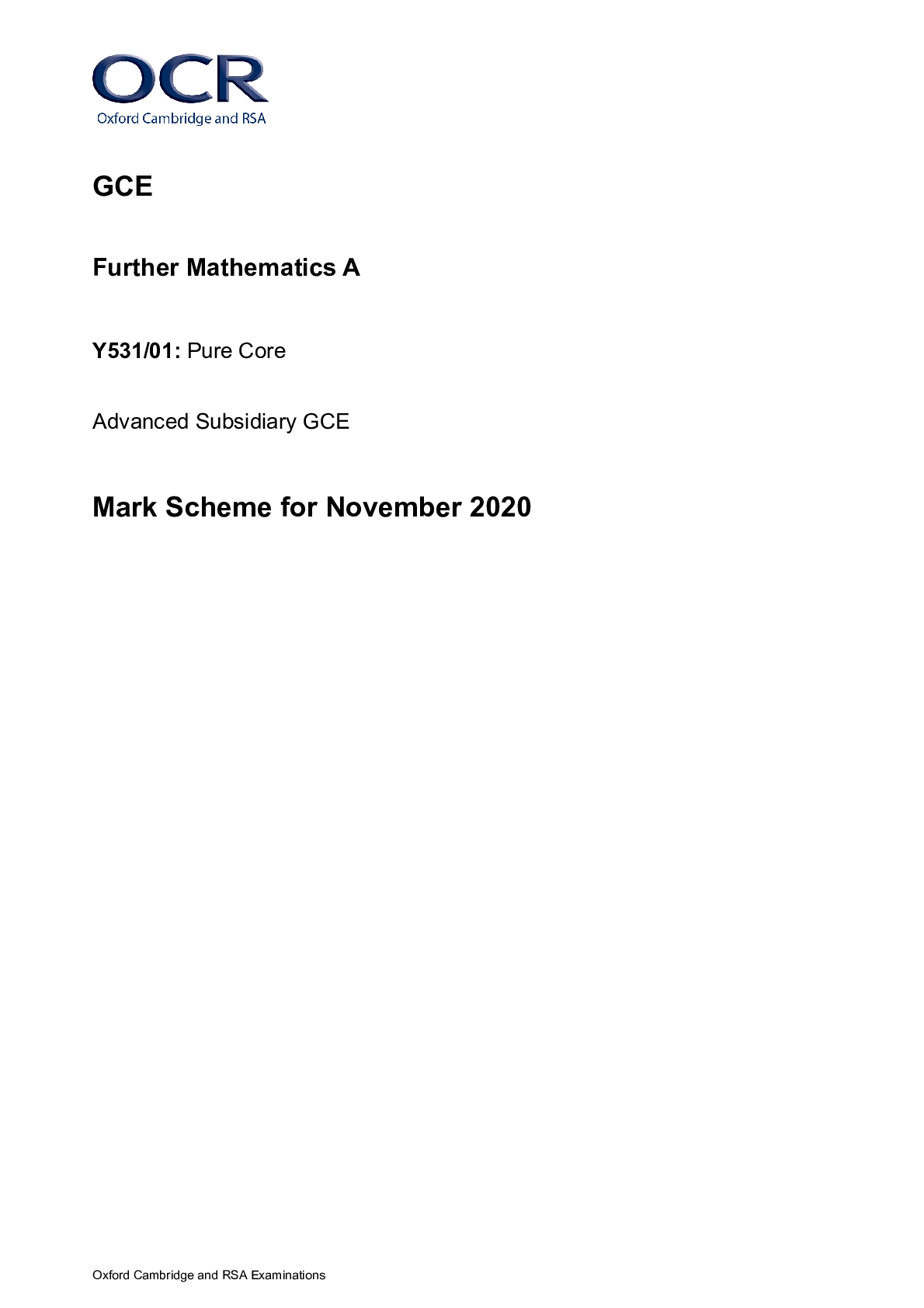
Buy this document to get the full access instantly
Instant Download Access after purchase
Add to cartInstant download
We Accept:

Reviews( 0 )
$6.50
Document information
Connected school, study & course
About the document
Uploaded On
Oct 10, 2022
Number of pages
18
Written in
Additional information
This document has been written for:
Uploaded
Oct 10, 2022
Downloads
0
Views
38

